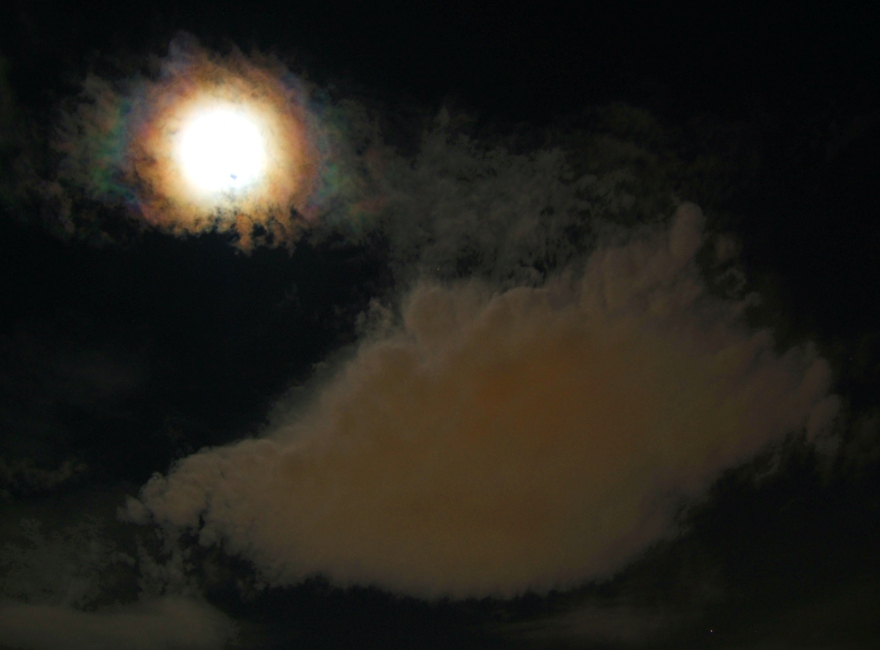Difference between revisions of "January 25, 2008"
| Line 7: | Line 7: | ||
What do you think every time you see a cloudy sky? Not pleasant thoughts I guess. Another lost opportunity to admire the heavens or to shoot some marvelous Moon close ups with the 18″ Reflector (I wish I had one!). This beautiful [http://www.lpod.org/?p=826 Moon Corona] proves that even in a cloudy sky, our favorite celestial body can produce marvelous scenes. Since this image is not evaluated and selected by Chuck, allow me not to reveal my name. I don’t want to take credit for choosing myself for LPOD! I can only give you two or three clues for myself: I’m from Greece, I DON’T like garlic and I do love my wife and my son with all my heart! The image is dedicated to my son Panagiotis.<br /> | What do you think every time you see a cloudy sky? Not pleasant thoughts I guess. Another lost opportunity to admire the heavens or to shoot some marvelous Moon close ups with the 18″ Reflector (I wish I had one!). This beautiful [http://www.lpod.org/?p=826 Moon Corona] proves that even in a cloudy sky, our favorite celestial body can produce marvelous scenes. Since this image is not evaluated and selected by Chuck, allow me not to reveal my name. I don’t want to take credit for choosing myself for LPOD! I can only give you two or three clues for myself: I’m from Greece, I DON’T like garlic and I do love my wife and my son with all my heart! The image is dedicated to my son Panagiotis.<br /> | ||
<br /> | <br /> | ||
| − | And some info about coronas from the [http://en.wikipedia.org/wiki/Corona_%28meteorology%29 Wikipedia]: A corona is produced by the diffraction of light from either the Sun or the Moon by individual small water droplets (and sometimes tiny ice crystals) of a cloud. The corona consists of small number of concentric colored rings around the celestial object and a central bright aureole. The angular size of the corona depends on the diameters of the cloud droplets - small droplets produce bright coronae. Coronae differ from [ | + | And some info about coronas from the [http://en.wikipedia.org/wiki/Corona_%28meteorology%29 Wikipedia]: A corona is produced by the diffraction of light from either the Sun or the Moon by individual small water droplets (and sometimes tiny ice crystals) of a cloud. The corona consists of small number of concentric colored rings around the celestial object and a central bright aureole. The angular size of the corona depends on the diameters of the cloud droplets - small droplets produce bright coronae. Coronae differ from [[January_18,_2008|haloes]] in that the latter are formed by refraction from comparatively large rather than small ice crystals.<br /> |
<br /> | <br /> | ||
<em>Editor's note: Chuck Wood is on vacation. Today's LPOD has been contributed by a member of the-Moon Wiki. You can [/How+to+Create+an+LPOD+Page do the same] while we await Chuck's return.</em><br /> | <em>Editor's note: Chuck Wood is on vacation. Today's LPOD has been contributed by a member of the-Moon Wiki. You can [/How+to+Create+an+LPOD+Page do the same] while we await Chuck's return.</em><br /> | ||
Revision as of 22:02, 4 February 2015
Sky Painting

image by: someone who truly loves his wife and son!
What do you think every time you see a cloudy sky? Not pleasant thoughts I guess. Another lost opportunity to admire the heavens or to shoot some marvelous Moon close ups with the 18″ Reflector (I wish I had one!). This beautiful Moon Corona proves that even in a cloudy sky, our favorite celestial body can produce marvelous scenes. Since this image is not evaluated and selected by Chuck, allow me not to reveal my name. I don’t want to take credit for choosing myself for LPOD! I can only give you two or three clues for myself: I’m from Greece, I DON’T like garlic and I do love my wife and my son with all my heart! The image is dedicated to my son Panagiotis.
And some info about coronas from the Wikipedia: A corona is produced by the diffraction of light from either the Sun or the Moon by individual small water droplets (and sometimes tiny ice crystals) of a cloud. The corona consists of small number of concentric colored rings around the celestial object and a central bright aureole. The angular size of the corona depends on the diameters of the cloud droplets - small droplets produce bright coronae. Coronae differ from haloes in that the latter are formed by refraction from comparatively large rather than small ice crystals.
Editor's note: Chuck Wood is on vacation. Today's LPOD has been contributed by a member of the-Moon Wiki. You can [/How+to+Create+an+LPOD+Page do the same] while we await Chuck's return.
Technical Details
Related Links
Lunar Ring More Rings Around the Moon
Yesterday's LPOD: A Sleepy Corner
Tomorrow's LPOD: Dome Students
COMMENTS?
Register, Log in, and join in the comments.



